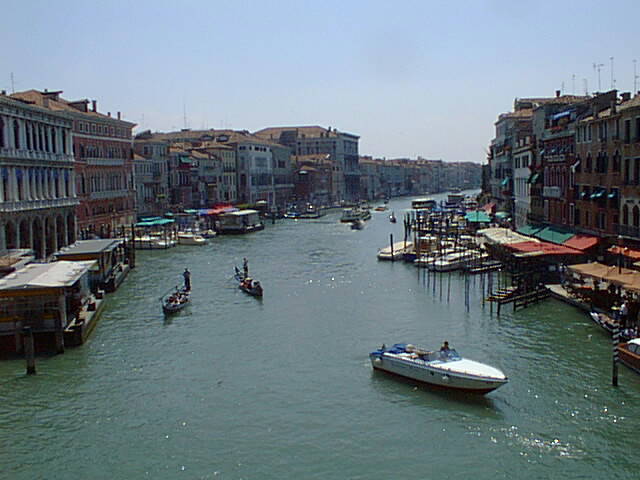
Once again I must apologize for a delay in posting our adventures. I have been running off a RAM disk to save power, and I accidentally dislodged the battery from my computer sometime yesterday evening (5 July); this caused the RAM disk and its contents, including all my web pages and pictures (but not e-mail messages, fortunately!), to vaporize. I reloaded all the pages through 4 July to my computer from my web host, but I couldn't reconstruct the page I had created but not yet posted for 5 July. So, since both 5 and 6 July were spent in Venice, I went back and re-shot some of the photos on Tuesday, and I'll give a combined report here. (Always back up your work to your hard drive!) Again, though, I'll have to hold off posting it until we reach Vienna, since we'll be on a train tonight (6 July) with no access to a phone line.
On Monday morning (5 July) most of us went in two groups on a two-hour walking tour of Venice, from our hotel to the Piazza San Marco. The city is smaller than you'd expect, considering its historical importance; I walked back from San Marco to our hotel, about halfway across the main city, in about 40 minutes (including time spent studying the map!). Space is at an extreme premium here (by comparison, we've got it easy in southern California!), so the streets are mostly rather narrow alleys by our standards, and there are very few parks. I also noticed that most open areas are named "campo", which means "field", or even "campiello" (a diminutive of "campo", I think), instead of "piazza", which seems to be reserved for large areas like the Piazza San Marco; the "campi" used to be grass-covered, but they've long since been paved over with stone. Of course, there's plenty to see in this small area; for one thing, there are 180 churches, which is more than one for each of the 118 islands of the city!

But as you know, the main streets of Venice are the canals. This is a view of the Grand Canal, which is about four miles long and several meters deep, as seen from the famous Rialto Bridge (Ponte Rialto). Until the Roman Empire started crumbling, the site of Venice was an inhospitable marshland; as waves of barbarians started coming through, the local people would take shelter in the marsh, then return to whatever was left of their homes and fields when the horde had departed. Then in the early 6th century the Lombards came through and stayed, so the locals were stuck on the islands. They drove pilings to the bedrock, using types of wood (oak and larch) that petrify instead of disintegrating when immersed in anoxic bottom water, and then built foundations on top of them. They began extracting salt from the sea water and trading in that, and expanded their trade reach and wealth until the Grand Canal was full of ships pulling up to the palatial headquarters of the trading families to load and unload their cargoes.
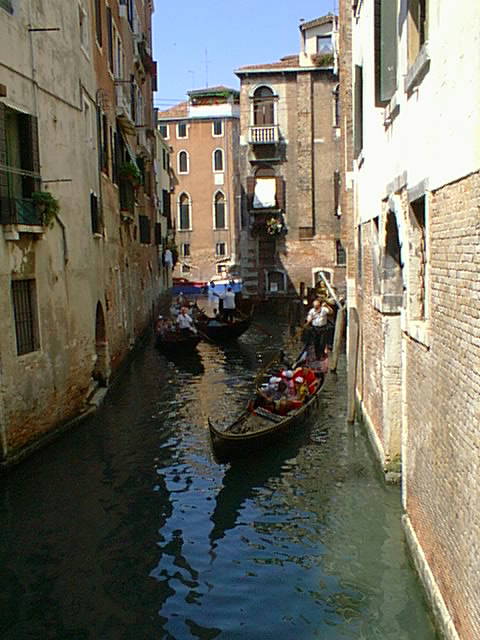
Of course, not all the canals of Venice are grand! This is a more typical example, and there are plenty that are narrower. In most cases the buildings come right up to the water, rather than having a landing or a sidewalk (called a "fondamenta"). After the walking tour on Monday, most of our group took a gondola ride around some of the smaller canals; the sun was hot, but there was a nice breeze and a lot of shady areas, so we had some pleasantly cool interludes. The water was a cloudy but not murky green, but you wouldn't want to swim in it--the canals constitute the sewer system for the city! (With a lot of engineers and scientists in the group, we ask a lot of questions about infrastructure...) I could hardly believe it when our guide told us; after all, this is the 20th century... But apparently the tides exchange the water thoroughly enough that it's not a problem; certainly I didn't notice any smell (and I didn't hear any other folks complaining), though I understand that if the water level gets low in the summer then this can change.
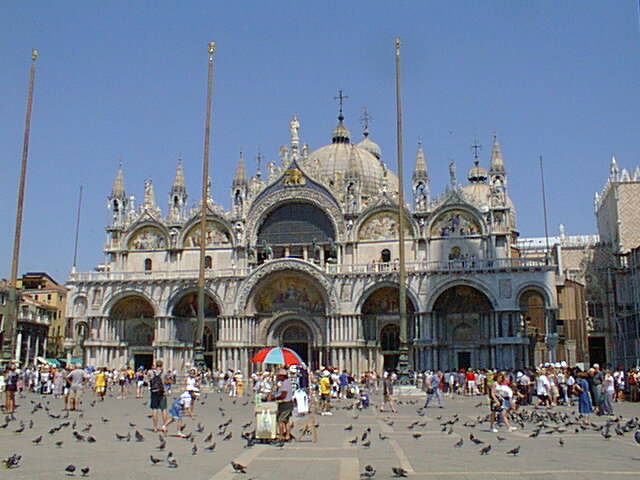
This is the focal point of Venice, the Basilica di San Marco (cathedral of St. Mark). The story of the structure sounds kind of like that of the Swamp Castle in "Monty Python and the Holy Grail": "The first one (9th century) burned down. So I built another one (10th century)--just to show 'em. That one burned down, fell over, and sank into the swamp--but the third one (11th century) stayed up!" Of course, a structure this grand takes a few centuries (in this case, about seven) to finish decorating; the main style is Byzantine, but there are also elements and examples of later styles present. The interior in particular is covered in Byzantine mosaics, many with the familiar gold-leaf background. Actually, it reminded me of the Cathedral of St. Louis, back home in Missouri, which is decorated in (a much later imitation of) the same style!
I understand there are some spoils of war incorporated into the structure as well. For example, many of the columns out front apparently came from other people's buildings, and the four horses above the main entrance (actually, these are copies--the originals are inside in the museum, out of the weather) made a centuries-long round trip from Rome through much of Europe as various conquerors claimed them, before they were brought back to Italy and placed in Venice. And, of course, the body of St. Mark the Evangelist was brought here by crusaders returning home to Venice; usually a quest for relics would come up with the hand of a saint, or a thighbone, or some other part, so the Venetians took it as a great sign of divine favor that they were able to acquire the entire body of a saint, let alone that of one of the Four Evangelists who wrote the Gospels.
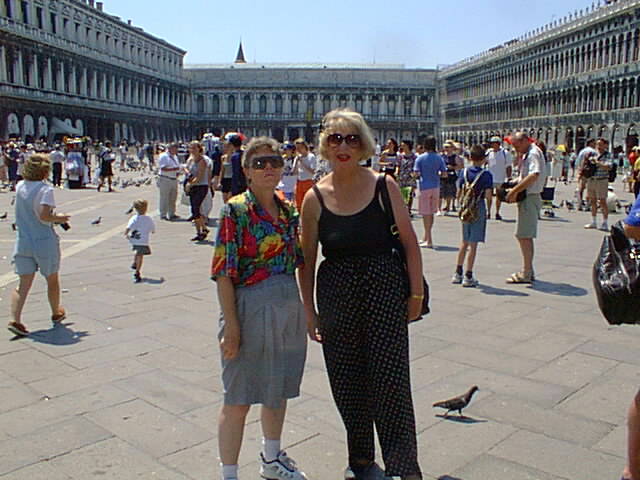
Here's a picture of two of our group, Sigi Lambros and Evelyn Gingrich, on the Piazza San Marco; there's a bit of a story here. The first musical play I did from the stage rather than the orchestra pit was "Bells Are Ringing", with the Manhattan Beach Community Church theater group. Sigi and I (and others) played, in one scene, a group of wealthy partygoers who sing a song, "Drop That Name", boasting about all the celebrities they have met and all the jet-set places they've been. Sigi's solo line was "Luncheon was fun at Twenty-One / Then flew right on to St. Mark's Piazza", so I just wanted to show you that life has imitated art yet again.
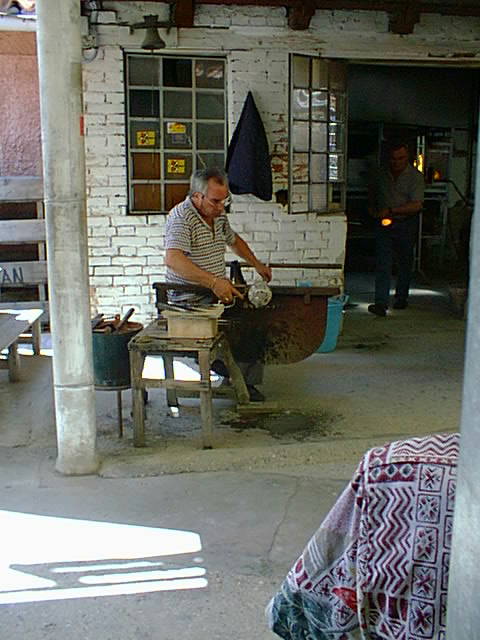
Monday afternoon and all of Tuesday were pretty much free time to explore Venice and environs on our own; on Monday evening most of us took a Vaporetto (water taxi) cruise along the Grand Canal, and on Tuesday morning about a third of us took a Vaporetto to the nearby islands of Murano and Lido. Murano is famous for its glassblowers; apparently they were mostly moved off the main islands of the city in the 12th and 13th century because most buildings were wooden at the time, and the glassblowers' furnaces presented a tremendous fire hazard. We visited the furnace of G. D. Furlan, and watched Giovanni (I think he's the "G." in the company name) make a vase with handles and a small swan figurine, working with one eye since his left one had a bandage on it! It was amazing to see lumps of glass spun, puffed, pinched, and pulled like taffy into these intricate forms (in the photo, his assistant is bringing out a red-hot blob to attach as the base). I bought a vase in the same form as the one we watched him make; next time you're at my place ask me to show it to you and describe how it was made. (I'm hand-carrying it back--it cost 40,000 lire, or about $20, but it would have cost 60,000 lire to ship it to America! At least two chandeliers were bought by people in our group; no word on how much those will cost to ship...)
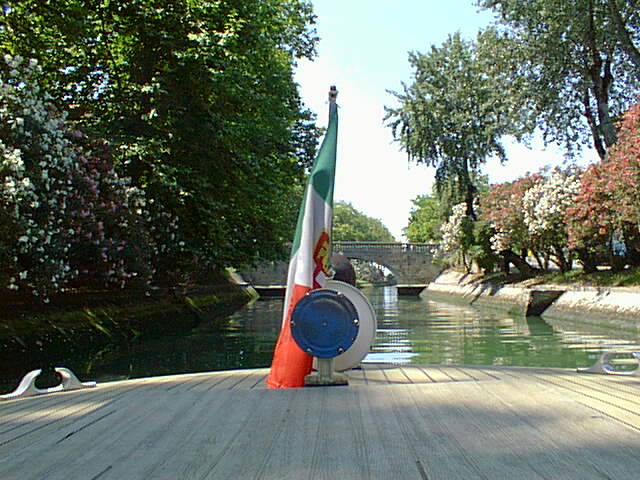
After visiting Murano, we continued to Lido before returning to St. Mark's Piazza or the hotel. "Lido" means "beach"; it's a long spit of land, a barrier island between the lagoon of Venice and the Adriatic Sea, and the beaches on the sea side are a big attraction. Unlike on the main islands of Venice, there were plenty of cars, trucks, and motor scooters here; I only saw one bicycle, even, in the narrow, twisty alleys of Venice! There were also a lot of more recent buildings, and much more space dedicated to parks and gardens, as you can see in the photo of a canal we traversed in our Vaporetto. Our guide knew the staff of the Excelsior Hotel, so they let us go through the lobby to the hotel's private beach; you could hardly run even a boogie board on the surf, but the sun and sand were nice. Several of our folks ended up going to Lido in another group and spending much of the day at the beach--So-Cal habits die hard!
After dinner, we will go to the railway station and bid farewell to Italy, as we take an overnight train to Vienna, Austria. Since I don't have a satellite modem, I won't be trying to dial in again until tomorrow night, as I noted at top. We've had a pretty hot time in Italy; the weather report I heard said that the heat wave will break when we reach Vienna, and many of us can hardly wait!
 To
Wednesday, 7 July 1999
To
Wednesday, 7 July 1999 Back
to choir tour itinerary
Back
to choir tour itinerary Back
to choir tour home page
Back
to choir tour home pagenew 6 July 1999, updated 13 July 1999